
Kashmir is the northernmost geographical region of the Indian subcontinent. Until the mid-19th century, the term "Kashmir" denoted only the Kashmir Valley between the Great Himalayas and the Pir Panjal Range. Today, the term encompasses a larger area that includes the India-administered territories of Jammu and Kashmir and Ladakh, the Pakistan-administered territories of Azad Kashmir and Gilgit-Baltistan, and the Chinese-administered territories of Aksai Chin and the Trans-Karakoram Tract.

Pakistan, officially the Islamic Republic of Pakistan, is a country in South Asia. It is the fifth-most populous country, with a population of over 241.5 million, having the second-largest Muslim population as of 2023. Islamabad is the nation's capital, while Karachi is its largest city and financial centre. Pakistan is the 33rd-largest country by area and the ninth-largest in Asia. Bounded by the Arabian Sea on the south, the Gulf of Oman on the southwest, and the Sir Creek on the southeast, it shares land borders with India to the east; Afghanistan to the west; Iran to the southwest; and China to the northeast. It shares a maritime border with Oman in the Gulf of Oman, and is separated from Tajikistan in the northwest by Afghanistan's narrow Wakhan Corridor.

The urial, also known as arkars, shapo, or shapu, is a wild sheep native to Central and South Asia. It is listed as Vulnerable on the IUCN Red List.
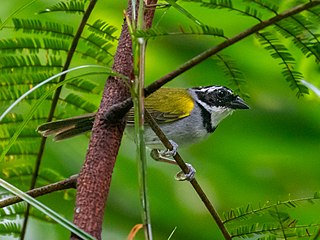
Arremon is a genus of neotropical birds in the family Passerellidae. With the exception of the green-striped brushfinch which is endemic to Mexico, all species are found in South America, with a few reaching Central America.

The olive finch is a species of bird in the family Passerellidae. Until recently, it was placed in the genus Lysurus.
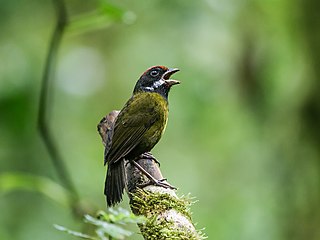
The sooty-faced finch is a species of bird in the family Emberizidae. Until recently, it was placed in the genus Lysurus.

The wildlife of Pakistan comprises a diverse flora and fauna in a wide range of habitats from sea level to high elevation areas in the mountains, including 195 mammal, 668 bird species and more than 5000 species of Invertebrates. This diverse composition of the country's fauna is associated with its location in the transitional zone between two major zoogeographical regions, the Palearctic, and the Oriental. The northern regions of Pakistan, which include Khyber Pakhtunkhwa and Gilgit Baltistan include portions of two biodiversity hotspot, Mountains of Central Asia and Himalayas.
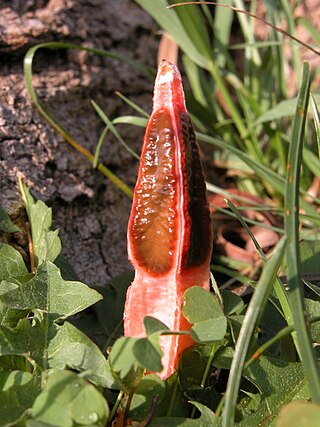
Lysurus mokusin, commonly known as the lantern stinkhorn, the small lizard's claw, or the ribbed lizard claw, is a saprobic species of fungus in the family Phallaceae. The fruit body consists of a reddish, cylindrical fluted stipe that is capped with several "arms". The arms can approach or even close in on each other to form a spire. The gleba—an olive-green slimy spore mass—is carried on the outer surface of the arms. The fruit body has an odor comparable to "fresh dog feces", "rotting flesh", or "sewage" when mature.

Lysurus is a genus of fungi in the Phallaceae, a family known collectively as the stinkhorn fungi. The species have a widespread distribution, but are specially prevalent in tropical areas.
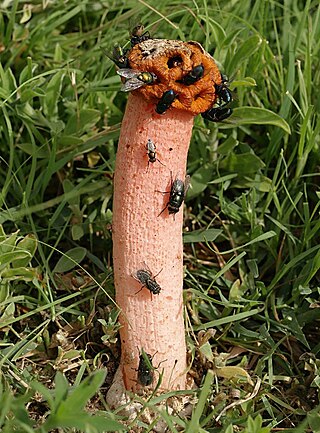
Lysurus periphragmoides, commonly known as the stalked lattice stinkhorn or chambered stinkhorn, is a species of fungus in the stinkhorn family. It was originally described as Simblum periphragmoides in 1831, and has been known as many different names before being transferred to Lysurus in 1980. The saprobic fungus has a pantropical distribution, and has been found in Africa, Asia, Australasia, and the Americas, where it grows on fertile ground and on mulch. The fruit body, which can extend up to 15 cm (5.9 in) tall, consists of a reddish latticed head placed on top of a long stalk. A dark olive-green spore mass, the gleba, fills the interior of the lattice and extends outwards between the arms. Like other members of the family Phallaceae, the gleba has a fetid odor that attracts flies and other insects to help disperse its spores. The immature "egg" form of the fungus is considered edible.
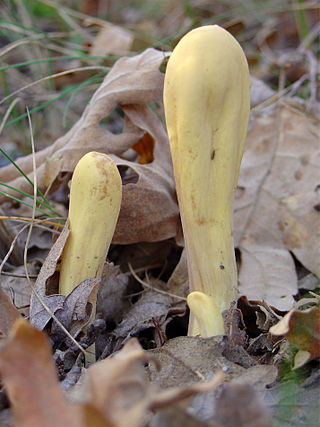
Clavariadelphus is a genus of club fungi in the family Clavariadelphaceae. The genus has a widespread distribution in temperate areas, and contains an estimated 19 species. The name might mean uterus-shaped club, from the Latin clava meaning club and the Greek delphus meaning uterus.
Barilius pakistanicus is a fish in genus Barilius of the family Cyprinidae.

Lysurus arachnoideus is a species of basidiomycete fungi in the genus Lysurus.
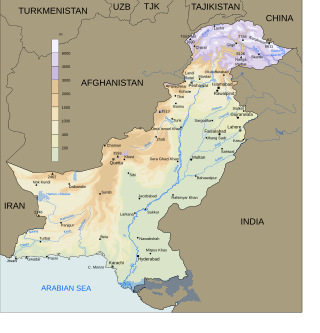
The fishing industry plays a significant part in the national economy of Pakistan. With a coastline of about 1,120 km, Pakistan has enough fishery resources that remain to be developed. Most of the population of the coastal areas of Sindh and Balochistan depends on fisheries for livelihood. It is also a major source of export earning.
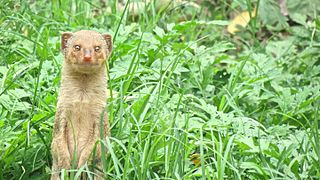
The small Indian mongoose is a mongoose species native to Iraq and northern India; it has also been introduced to several Caribbean and Pacific islands.
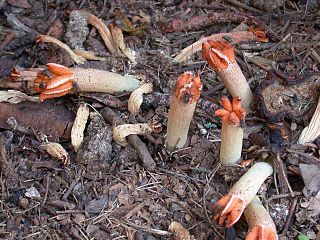
Lysurus cruciatus or the lizard's-claw stinkhorn is a species of fungus in the stinkhorn family. It was first described scientifically in 1845 by French botanists François Mathias René Leprieur and Camille Montagne as Aserophallus cruciatus. German mycologist Paul Christoph Hennings transferred it to the genus Lysurus in 1902. Its fruit bodies feature a white, cylindrical tube supporting a cluster of hollow, reddish pointed arms whose surface is covered with foul-smelling spore mass, or gleba. The gleba is brownish to greenish in color, and contains spores with dimensions of 3–4 by 1.5–2 μm.
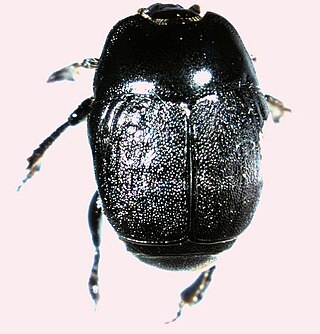
Neopachylopus is a genus of clown beetles in the family Histeridae. There are about six described species in Neopachylopus.
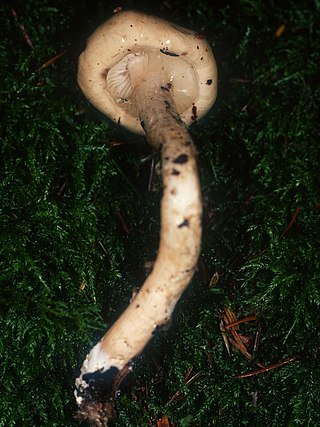
Zhuliangomyces is a genus of mushroom-forming fungi in the family Amanitaceae in order Agaricales. Analysis of DNA sequences was used to show that Zhuliangomyces was separate from Limacella which is similar in appearance and the genus name Myxoderma was adopted. The name Myxoderma was previously used for a genus of Cyanobacteria and the fungal generic name was replaced by Zhuliangomyces.
Induszalim is an extinct genus of mesoeucrocodylian reptile from the Pab Formation of Balochistan, Pakistan. The type, and only species, I. bala, was named and described in 2006.
Punjabia is a genus of fungi in the family Psathyrellaceae. The genus is monotypic and contains the single species Punjabia pakistanicus which was previously classified as Coprinellus pakistanicus.
















